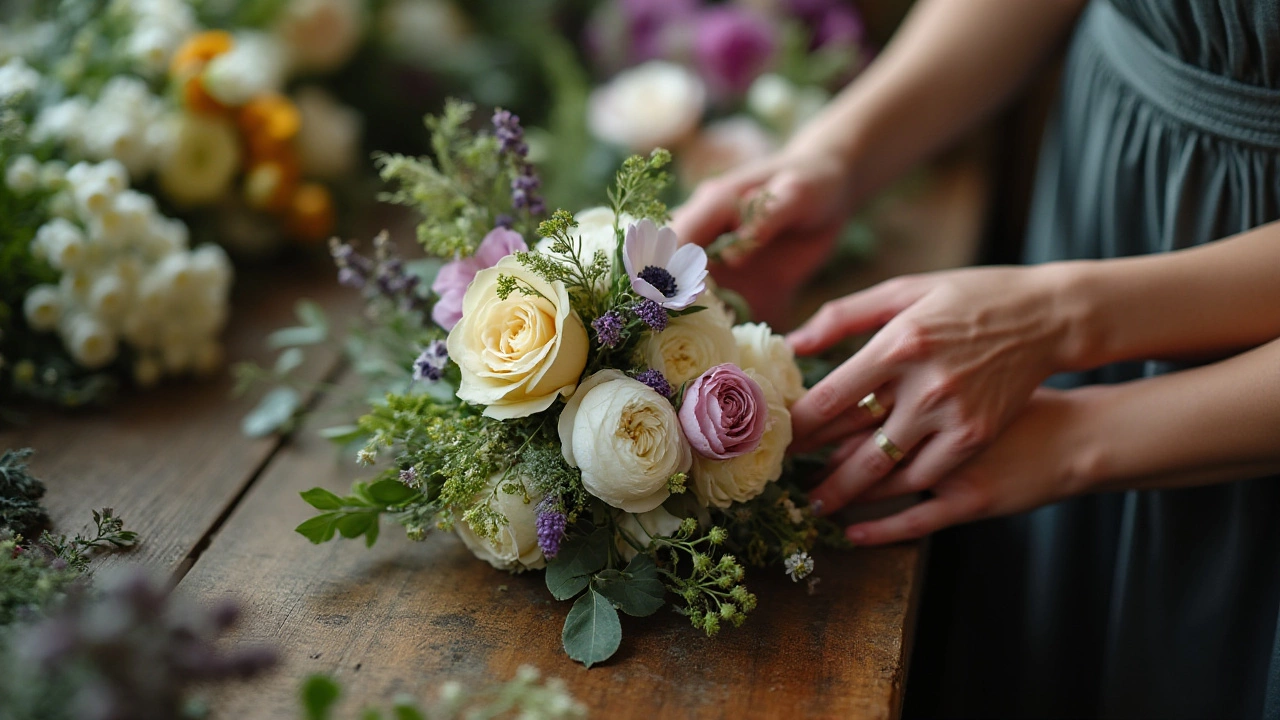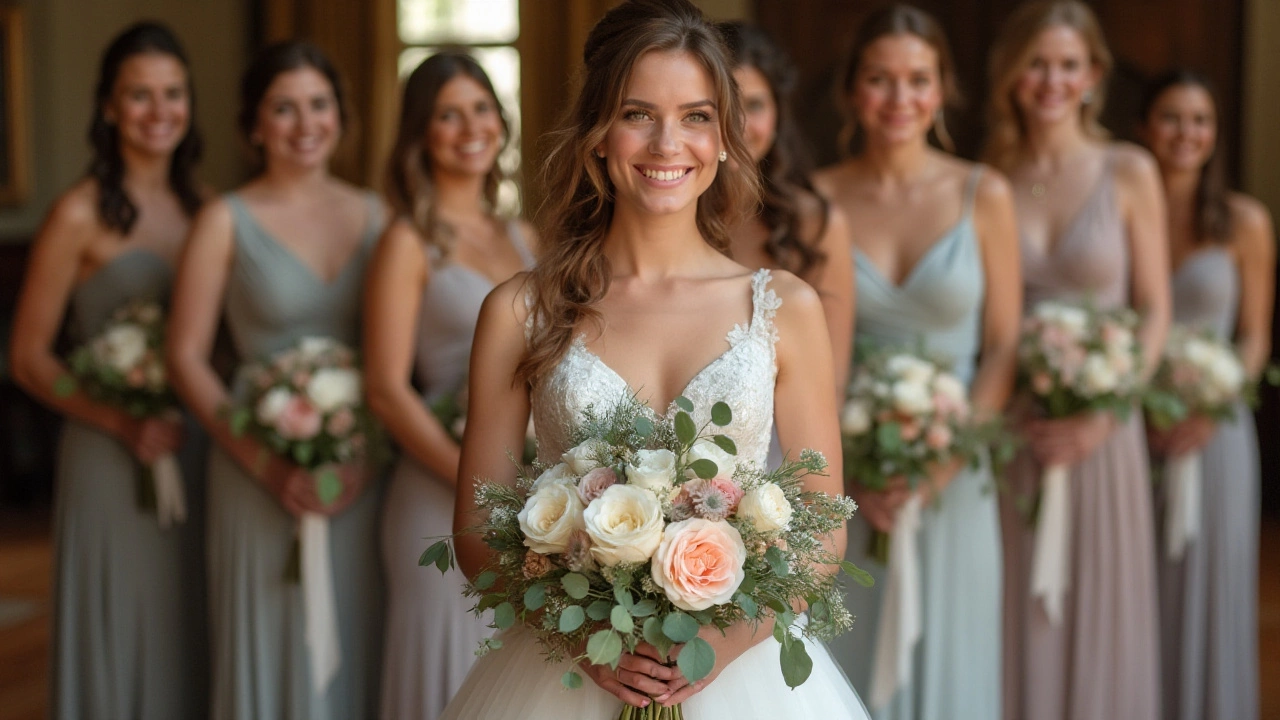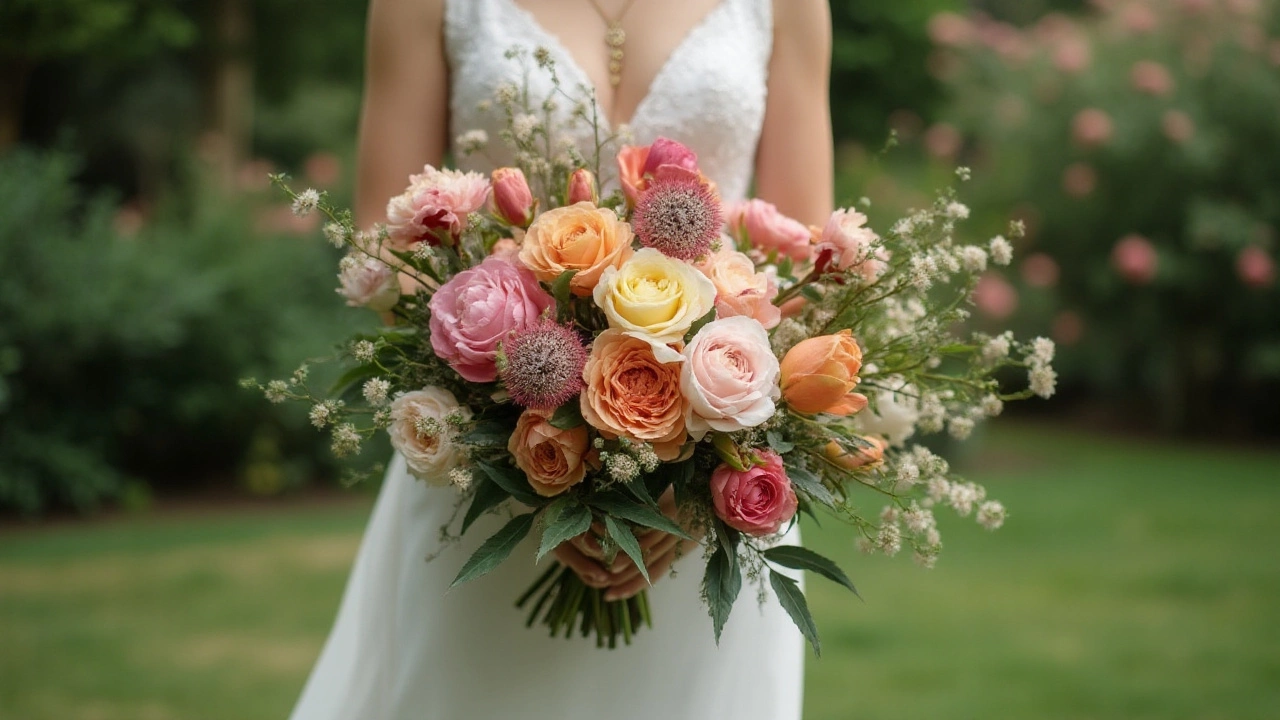The charm of a wedding bouquet lies within its delicate blooms and the vibrant stories they weave together. Picking the perfect flowers can be one of the most enchanting aspects of wedding planning, as each petal contributes to an unforgettable display of love.
Flowers have long been a symbol of romance and beauty, and choosing them can feel like painting a moment in time. Whether you are drawn to classic roses or tempted by an unusual bloom, the choice of flowers should reflect both personal taste and the spirit of the celebration.
- The All-Time Favorites
- Seasonal Blooms
- Symbolic Meanings
- Color Coordination Tips
- Unique and Exotic Choices
The All-Time Favorites
When it comes to crafting a stunning bridal bouquet, certain flowers reign supreme across eras and cultures, due to their timeless elegance and versatility. Roses are often termed the quintessential expression of romance, capturing hearts with their abundant petals and rich hues, from pure whites to passionate reds. Each variety speaks its own language of love, with garden roses providing a lush, soft touch, while long-stemmed beauties offer a sense of grandeur. Peonies, with their opulent blooms, are another beloved choice, adored for their romantic charisma and full-bodied allure. They are perfect for spring weddings as their blooming season brings a natural abundance and fragrance that is hard to resist.
Another perennial favorite is the lily, which comes in various forms, each with its unique charm and meaning. The classic calla lily exudes sophistication and elegance, often seen in modern, minimalist bridal flower arrangements. Its sleek form makes it a perfect choice for a clean and sophisticated aesthetic. Tulips, too, are cherished for their versatility and wide array of colors, reflecting everything from perfect love to declarations of passion depending on their shade. As Audrey Hepburn once said, "To plant a garden is to believe in tomorrow," a sentiment that resonates deeply with the love and hope exhibited in bridal florals.
Hydrangeas, with their voluminous clusters, offer brides a chance to play with texture and color in a unique way. These blooms can transition from soft pastels to vibrant blues, allowing for a creative palette. Adding the delicate touch of baby's breath can create a dreamy, ethereal feel, acting as the understated companion that gracefully enhances the bouquet's primary stars. Orchids are yet another choice for those seeking an exotic twist. Known for their fascinating structures and diversity, orchids can add a touch of drama and uniqueness, captivating attention effortlessly.
For those interested in adding a layer of tradition, the stephanotis flower, historically a wedding staple, symbolizes marital happiness and carries with it a vintage charm that many brides find appealing. As popularity ebbs and flows, these classic choices remain steadfast, favored for their beauty, versatility, and the deep symbolic meanings they carry into the marriage journey. Designing a bouquet with these old favorites can indeed make the wedding day extra special, resonating with centuries of tradition and universal admiration.
Seasonal Blooms
When planning wedding florals, understanding the magic of seasonal blooms can bring a natural charm to your bouquet. Just as each season unfolds with its unique palette of hues and fragrances, the choice of flowers can capture the essence of the time of year your nuptials take place. Imagine the soft pastels of springtime blossoms or the rich, velvety tones of winter flowers gracing your special day. Opting for blooms that are naturally in season can also mean fresher flowers and a more cost-effective approach.
Spring weddings, for instance, offer a bounty of beautiful blossoms. Delicate peonies are often cherished for their full-bodied blooms and romantic allure. Known as a symbol of prosperity and good fortune, peonies can be a meaningful addition to your bridal bouquet. Tulips, available in countless colors, also herald the arrival of spring with their simple yet elegant presence, each color bringing its symbolism—red for love, yellow for hope, and white for peace.
Summer presents a vibrant array of choices, from sunflowers that bring a burst of sunshine with their cheerful demeanor to the classic rose, beloved for its timelessness. A summertime bride may also consider daisies, whose whimsical appeal adds a touch of innocence and playfulness. As British author John Keats beautifully said, "The poetry of earth is never dead," seasonal blooms truly reflect this sentiment, capturing the ethereal beauty of each season in their petals.
Autumn weddings provide the opportunity to embrace the warmth and depth that fall flowers offer. Dahlias, with their intricate pattern and dense petals, are heartily favored for their striking appearance. Chrysanthemums, available in yellows, oranges, and reds, echo the hues of changing leaves, and bring a sense of grounded comfort to floral arrangements. The spicy, earthy scent of marigolds can also add a touch of tradition and wisdom to a fall bouquet.
Winter, though often perceived as sparse in floral offerings, holds its own with luxurious options. Amaryllis, with their bold and dramatic blooms, stand as a winter's fashionable statement piece. The elegant anemone, with its stark contrast of white petals and a black center, offers a modern twist. These choices can create a striking balance against the wintry backdrop, proving that even in the coldest months, nature's artistry shines.
To craft a stunning bouquet that resonates with the time of year, align your selection with your wedding date. Selecting wedding flowers that reflect seasonal availability enhances the event's authenticity and allows you to work harmoniously with nature's timeline. If your selections honor the season, the arrangement will indeed blossom with character, adding opulence and allure to your special occasion.

Symbolic Meanings
Flowers have whispered timeless messages throughout the ages, carrying meanings that transcend simple beauty. Understanding these symbolic meanings can add a deeper layer to choosing your wedding flowers. Each bloom can speak volumes in the language of love and gratitude. For example, the classic rose, especially in its red form, is universally acknowledged as the definitive symbol of love and passion. White roses, on the other hand, denote purity and new beginnings, making them a key choice for many brides.
The peony, with its lush, full bloom, symbolizes romance and prosperity. In many cultures, it is considered a harbinger of fortune and happiness, making it ideal for newlyweds embarking on a shared journey. Lilies, often associated with rebirth and motherhood, bring a message of purity and commitment. This makes them a lovely addition for couples looking to reflect a deeper spiritual connection on their special day.
Even the modest wildflower, often overlooked amid more flamboyant counterparts, holds unique meanings tied to freedom and natural beauty. Incorporating these seemingly ordinary flowers can lend a rustic charm and symbolize letting love grow wildly and organically. For those wanting a touch of the mystical, the orchid’s exotic allure and strong symbolic association with refinement, beauty, and allure offer exactly that.
“Each flower has a story, a narrative that weaves beautifully into the fabric of a couple’s life,” noted Frances King, a celebrated floral designer known for her work with wedding flowers.
This magical language of flowers allows brides to craft bouquets that tell stories, create memories, and evoke feelings that words might fail to capture.
Creating a bouquet that threads these symbolic whispers can ensue a meaningful and memorable nuptial experience. While it can be tempting to choose your bouquet based solely on visual appeal, blending aesthetics with symbolism ensures your bouquet isn't just a feast for the eyes, but a meaningful ode to love in all its layered beauty.
Color Coordination Tips
Color coordination is a crucial element in designing a wedding bouquet that not only looks stunning but also reflects the theme and mood of the wedding. When selecting colors, it's essential to consider the wedding's color palette, which often includes hues that match the bridal gown, bridesmaids' dresses, and overall decor. The right color scheme can pull everything together, creating a harmonious look. A balanced bouquet doesn't just consist of matching colors; it's about finding complementary shades that naturally enhance one another. A popular approach is the use of analogous colors, which are neighboring colors on the color wheel, such as purple, blue, and teal, or yellow, orange, and red, which create a serene and cohesive appearance.
Another important factor to consider is the season of the wedding. Different seasons offer various blooms with specific color stories. For example, spring weddings often feature pastel colors such as blush, lavender, and mint, while summer might showcase bolder colors like bright pinks, sunny yellows, and deep purples. Fall weddings are perfect for rich tones such as burgundy, burnt orange, and olive green, which resonate with the autumnal backdrop. Winter weddings can take advantage of the white landscape using crisp whites, silvers, and deep reds to create a striking contrast. Selecting fresh, in-season blooms not only enhances the bouquet's visual appeal but also supports sustainable practices.
When considering color coordination for bridal bouquet, texture and contrast play an equally important role as hues. By incorporating varying shades and textures, such as pairing soft roses with delicate baby's breath or bold peonies with intricate anemones, the bouquet achieves depth and dimension. Textures can be explored further by adding greenery or accents like thistles, berries, or branches, providing a dynamic visual experience. It's often these subtle contrasts in tone and texture that make a bouquet memorable and distinctive, blending seamlessly with the wedding's aesthetic.
One expert suggests thinking about the emotions that colors evoke when planning wedding flower arrangements. According to color psychology, different colors elicit different feelings. For example, blue is often associated with serenity and trust, while red evokes passion and excitement. "Choosing colors that resonate with your emotions can add a personal touch to the bouquet," suggests floral designer Emily Carter.
"Color is a powerful way to convey emotion, and when thoughtfully chosen, it can tell a story that's uniquely yours."By selecting colors that are meaningful to you and your partner, you can create a bouquet that represents your personal journey together.
To assist in visualizing and coordinating colors, some couples work with color swatches or mood boards, which can be immensely helpful tools for both the couple and the florist. These tools allow the exploration of different combinations and ensure that the final selection complements all aspects of the wedding. Additionally, using online design tools that provide color palette inspiration can spark creativity and offer suggestions for pairing different shades effectively. This approach can prevent last-minute crises and ensure a consistent visual theme across the wedding day.

Unique and Exotic Choices
Diving into the world of wedding flowers, it's an adventure to explore the realm of unique and exotic blooms. These exceptional choices can set your bridal bouquet apart by adding a touch of individuality to your ceremony. One flower making waves in wedding trends is the protea, with its bold structure and varied colors. Originating from South Africa, proteas are named after the Greek god Proteus, capable of changing shapes and forms, just like this versatile flower adapts to any bouquet theme. It's not just its exotic allure that captivates brides but its symbolism of change and transformation, ideal for weddings.
Another striking option is the anemone, known for its vibrant colors and delicate petals. These flowers can be both romantic and dramatic, often characterized by a dark center that creates a beautiful contrast with their petals. Anemones are known to be a sign of anticipation, a fitting sentiment as brides await their big day. The anemone can be paired beautifully with other seasonal blooms or stand alone in a minimalist arrangement that speaks volumes in elegance.
The bird of paradise also offers a spectacular addition with its unique shape and tropical vibe. Resembling the plumage of a vibrant bird in flight, this flower brings a lively splash of color and energy. It's particularly popular for destination weddings or couples looking to add a touch of the tropics to their celebration. Symbolizing joyfulness, these flowers can invigorate any bridal bouquet, injecting it with a sense of joy and adventure.
"The right flower arrangement can transform a space and create a lasting impression," says floral designer Jenna Thompson. "Choosing exotic flowers is about celebrating uniqueness and the beauty that comes from nature's most extravagant creations."
When it comes to flower arrangements featuring unique blooms, orchids are another favorite due to their wide range of colors and distinctive appearance. Orchids are associated with beauty and strength, making them a significant choice in wedding decor. Their stunning, detailed flowers can create a modern and sophisticated feel or serve as a gentle reminder of exotic landscapes.
Incorporating these wedding decor options requires careful consideration of the desired theme and color palette. Exotic choices often require a little extra care, but their impact can be unparalleled. To ensure longevity and freshness, it's crucial to consult with your florist about the best ways to preserve these blooms, especially in varying climates and conditions. With careful selection and thoughtful arrangement, unique flowers can truly narrate your love story through their beauty.
For those looking to make a statement, combining multiple exotic blooms together can bring a unique twist to your wedding bouquet. This technique can capture the essence of both traditional and modern aesthetics, merging them into an unforgettable bouquet. As couples continue to personalize their ceremonies, the role of exotic and unique flowers grows, allowing creativity to lead the way.

